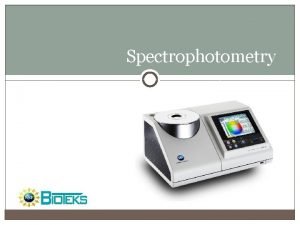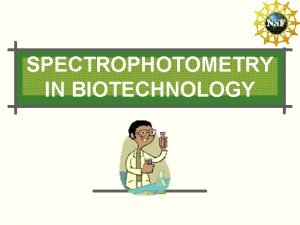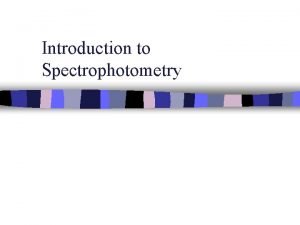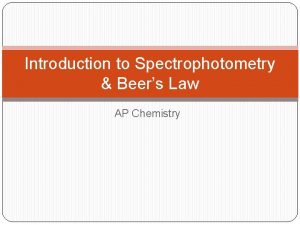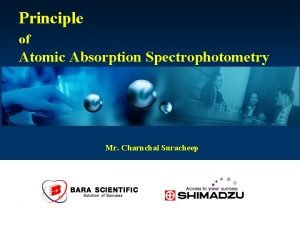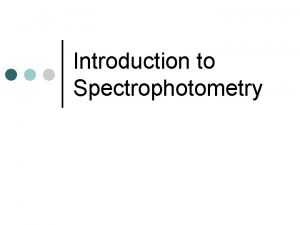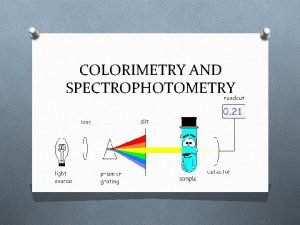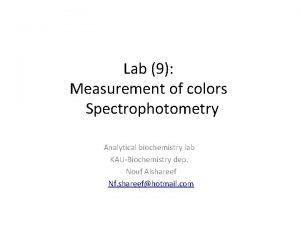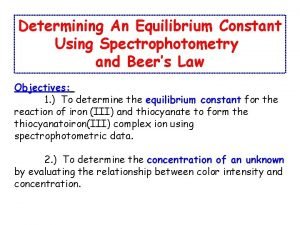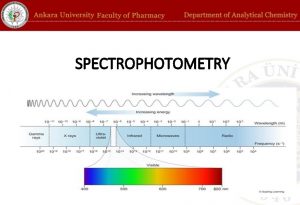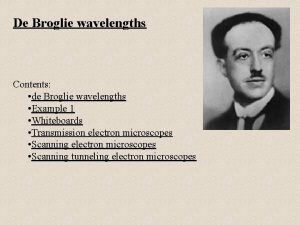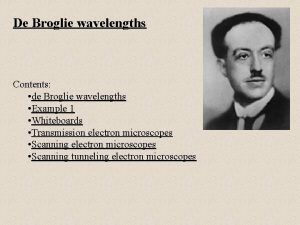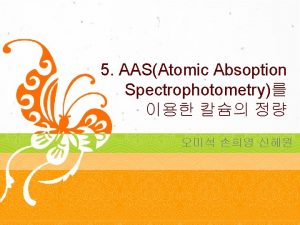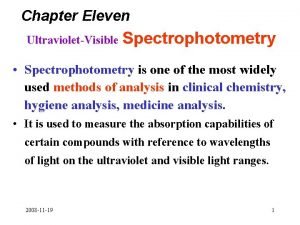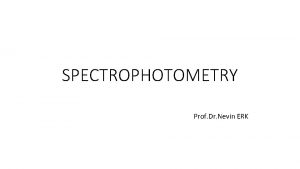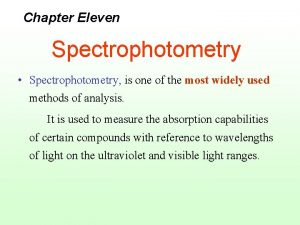SPECTROPHOTOMETRY White light contains all wavelengths of light











- Slides: 11

SPECTROPHOTOMETRY White light contains all wavelengths of light in the visible region of the EM. A substance appears colored because it absorbs light at one or more wavelengths in the visible region and transmits the remaining wavelengths. The human eye, a type of EM radiation detector, sees the transmitted light.

COMPLEMENTARY COLORS The color of the light transmitted is complementary to the color of light absorbed. From the color wheel, you can see that a substance that absorbs blue wavelengths transmits orange wavelengths, and so appears orange to the human eye. What color does a red object absorb?

SPECTROPHOTOMETRY A spectrophotometer uses this concept to determine the relative absorbance or transmittance of wavelengths of light by a solute in solution. A wavelength of light is specified, and then beamed through a small test tube (cuvette) of solution to determine the relative amount transmitted or absorbed.

SPECTROPHOTOMETRY

SPEC 20 Display: λnm • % • MODE Cuvette chamber Wavelength adjustment On/Off; Transmission adjustment Absorbance adjustment

CALIBRATING THE SPEC Set the WAVELENGTH (large knob on top) to 550 nm Set MODE to transmittance With the sample compartment empty and the cover closed, adjust the ZERO knob (on the left) until transmittance reads 0%

RUNNING A BLANK o Fill a cuvette ~2/3 full with distilled water. This is the BLANK, the reference trial. o Wipe off the outside with a Kim-Wipe and insert into the sample holder o Adjust the light control knob (RIGHT) until the transmittance registers 100%

RUNNING A SAMPLE Replace the DI cuvette with one ~2/3 filled with a test sample (bromthymol blue). Close the cover. Read & record % transmittance. Transmission below 30% indicates a too concentrated sample. Dilute with DI water. Make an approximate 50% dilution of the stock sample. Pour mixture between cuvettes to mix. Wipe down the glass. Recalibrate to 100% transmittance with the blank. Run diluted test sample. Read/record. Repeat with a final 50% dilution.

Ref: https: //msu. edu/course/lbs/159 h/Spectrophotometry 04. pdf

SIDEBAR: PLANTS ABSORB A LOT OF LIGHT ENERGY……why don’t they emit light/glow? Energy converted to small energytransporting molecules – ATP - to be used to generate glucose

FINDING THE ABSORPTION SPECTRUM OF PLANTS Plants contain primary and secondary pigments that are necessary for absorbing energy – in the form of excited electrons - used in the process of photosynthesis We can use the absorption spectrum of a sample to derive the wavelengths most used to excite the electrons of the pigments in plants leaves Bring in some leaves – you’ll make a solution of the pigments and find the absorbency spectrum of each Use the color wheel and spectrum diagrams to predict what wavelengths your solution will absorb.
 Wavelength of electromagnetic spectrum
Wavelength of electromagnetic spectrum Beer-lambert law statement
Beer-lambert law statement Spectrophotometry in chemistry
Spectrophotometry in chemistry Blank a spectrophotometer
Blank a spectrophotometer Readout device
Readout device Spectroscopy and spectrophotometry
Spectroscopy and spectrophotometry Beer's law formula
Beer's law formula Principle of absorption
Principle of absorption Spectrophotometry introduction
Spectrophotometry introduction Colorimetry colour wheel
Colorimetry colour wheel Complementary colors spectrophotometer
Complementary colors spectrophotometer Constant
Constant


